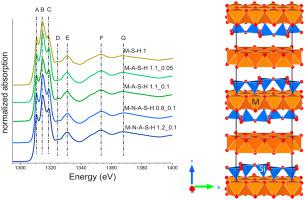当前位置:
X-MOL 学术
›
Appl. Geochem.
›
论文详情
Our official English website, www.x-mol.net, welcomes your
feedback! (Note: you will need to create a separate account there.)
Structural characterisation of Magnesium (Sodium) Aluminium Silicate Hydrate (M-(N)-A-S-H) phases by X-ray absorption near-edge spectroscopy
Applied Geochemistry ( IF 3.1 ) Pub Date : 2020-12-01 , DOI: 10.1016/j.apgeochem.2020.104750 Marika Vespa , Camelia Borca , Thomas Huthwelker , Barbara Lothenbach , Rainer Dähn , Erich Wieland
Applied Geochemistry ( IF 3.1 ) Pub Date : 2020-12-01 , DOI: 10.1016/j.apgeochem.2020.104750 Marika Vespa , Camelia Borca , Thomas Huthwelker , Barbara Lothenbach , Rainer Dähn , Erich Wieland

|
Abstract Magnesium silicate hydrate phases (M-S-H) have been observed forming in low pH cements, which came in contact with Mg-rich ground waters or argillaceous rock formations, such as Opalinus Clay. Their crystallographic structure has been suggested to be a purely ordered sheet-like phyllosilicate with a tetrahedral octahedral (TOT O) layering, i.e. similarly to a talc plus brucite structure. In nature, Mg phyllosilicates with this type of layering contain several type of cations, in particular Al, as well as alkaline earth metals. This study shows that the X-ray near-edge spectra of synthesised Mg-Al- silicate hydrates and Mg-Al-Na silicate hydrates (M-A-S-H and M-N-A-S-H) show distinct differences to M-S-H, indicating the possible accommodation of Al in their structure. This is further supported by the great similarity of the spectra to natural Mg–Al containing phyllosilicates, i.e. clinochlore, having a TOT O layering. The results, furthermore, suggest that Na is not taken up in the structure due to the strong similarities of the M-N-A-S-H with the M-A-S-H phases. The comparison of the latter spectra with natural references show high resemblance not only with clinochlore, but also with sepiolite, a Mg containing phyllosilicate with water molecules bridging between broken octahedral chains. It is, therefore, suggested that the Mg in the M-(N)-A-S-H phases is bound similarly to clinochlore with a TOT O layering and that water molecules or OH groups are present between broken octahedral layers. Aluminium is possibly accommodated in the tetrahedral and/or octahedral layers.
中文翻译:

通过 X 射线吸收近边光谱法表征镁(钠)硅酸铝水合物(M-(N)-ASH)相
摘要 已观察到硅酸镁水合物相 (MSH) 在与富含镁的地下水或泥质岩层(如 Opalinus Clay)接触的低 pH 水泥中形成。它们的晶体结构被认为是具有四面体八面体 (TOT O) 分层的纯有序片状层状硅酸盐,即类似于滑石加水镁石结构。在自然界中,具有这种层状结构的 Mg 层状硅酸盐含有多种类型的阳离子,尤其是 Al,以及碱土金属。该研究表明,合成的 Mg-Al-硅酸盐水合物和 Mg-Al-Na 硅酸盐水合物(MASH 和 MNASH)的 X 射线近边光谱显示出与 MSH 的明显差异,表明其结构中可能存在 Al。光谱与天然含 Mg-Al 的页硅酸盐(即斜绿石)具有 TOT O 层状结构的极大相似性进一步支持了这一点。此外,结果表明,由于 MNASH 与 MASH 相的强烈相似性,Na 没有被吸收到结构中。后一种光谱与自然参考的比较表明,不仅与斜绿石高度相似,而且与海泡石高度相似,海泡石是一种含镁的页硅酸盐,水分子桥接在断开的八面体链之间。因此,这表明 M-(N)-ASH 相中的 Mg 与具有 TOT O 分层的斜绿石相似,并且水分子或 OH 基团存在于破碎的八面体层之间。铝可能容纳在四面体和/或八面体层中。斜绿素,具有 TOT O 分层。此外,结果表明,由于 MNASH 与 MASH 相的强烈相似性,Na 没有被吸收到结构中。后一种光谱与自然参考的比较表明,不仅与斜绿石高度相似,而且与海泡石高度相似,海泡石是一种含镁的页硅酸盐,水分子桥接在断开的八面体链之间。因此,这表明 M-(N)-ASH 相中的 Mg 与具有 TOT O 分层的斜绿石相似,并且水分子或 OH 基团存在于破碎的八面体层之间。铝可能容纳在四面体和/或八面体层中。斜绿素,具有 TOT O 分层。此外,结果表明,由于 MNASH 与 MASH 相的强烈相似性,Na 没有被吸收到结构中。后一种光谱与自然参考的比较表明,不仅与斜绿石高度相似,而且与海泡石高度相似,海泡石是一种含镁的页硅酸盐,水分子桥接在断开的八面体链之间。因此,这表明 M-(N)-ASH 相中的 Mg 与具有 TOT O 分层的斜绿石相似,并且水分子或 OH 基团存在于破碎的八面体层之间。铝可能容纳在四面体和/或八面体层中。表明由于 MNASH 与 MASH 相的强烈相似性,Na 没有被吸收到结构中。后一种光谱与自然参考的比较表明,不仅与斜绿石高度相似,而且与海泡石高度相似,海泡石是一种含镁的页硅酸盐,水分子桥接在断开的八面体链之间。因此,这表明 M-(N)-ASH 相中的 Mg 与具有 TOT O 分层的斜绿石相似,并且水分子或 OH 基团存在于破碎的八面体层之间。铝可能容纳在四面体和/或八面体层中。表明由于 MNASH 与 MASH 相的强烈相似性,Na 没有被吸收到结构中。后一种光谱与自然参考的比较表明,不仅与斜绿石高度相似,而且与海泡石高度相似,海泡石是一种含镁的页硅酸盐,水分子桥接在断开的八面体链之间。因此,这表明 M-(N)-ASH 相中的 Mg 与具有 TOT O 分层的斜绿石相似,并且水分子或 OH 基团存在于破碎的八面体层之间。铝可能容纳在四面体和/或八面体层中。含镁的层状硅酸盐,水分子桥接在断开的八面体链之间。因此,这表明 M-(N)-ASH 相中的 Mg 与具有 TOT O 分层的斜绿石相似,并且水分子或 OH 基团存在于破碎的八面体层之间。铝可能容纳在四面体和/或八面体层中。含镁的层状硅酸盐,水分子桥接在断开的八面体链之间。因此,这表明 M-(N)-ASH 相中的 Mg 与具有 TOT O 分层的斜绿石相似,并且水分子或 OH 基团存在于破碎的八面体层之间。铝可能容纳在四面体和/或八面体层中。
更新日期:2020-12-01
中文翻译:

通过 X 射线吸收近边光谱法表征镁(钠)硅酸铝水合物(M-(N)-ASH)相
摘要 已观察到硅酸镁水合物相 (MSH) 在与富含镁的地下水或泥质岩层(如 Opalinus Clay)接触的低 pH 水泥中形成。它们的晶体结构被认为是具有四面体八面体 (TOT O) 分层的纯有序片状层状硅酸盐,即类似于滑石加水镁石结构。在自然界中,具有这种层状结构的 Mg 层状硅酸盐含有多种类型的阳离子,尤其是 Al,以及碱土金属。该研究表明,合成的 Mg-Al-硅酸盐水合物和 Mg-Al-Na 硅酸盐水合物(MASH 和 MNASH)的 X 射线近边光谱显示出与 MSH 的明显差异,表明其结构中可能存在 Al。光谱与天然含 Mg-Al 的页硅酸盐(即斜绿石)具有 TOT O 层状结构的极大相似性进一步支持了这一点。此外,结果表明,由于 MNASH 与 MASH 相的强烈相似性,Na 没有被吸收到结构中。后一种光谱与自然参考的比较表明,不仅与斜绿石高度相似,而且与海泡石高度相似,海泡石是一种含镁的页硅酸盐,水分子桥接在断开的八面体链之间。因此,这表明 M-(N)-ASH 相中的 Mg 与具有 TOT O 分层的斜绿石相似,并且水分子或 OH 基团存在于破碎的八面体层之间。铝可能容纳在四面体和/或八面体层中。斜绿素,具有 TOT O 分层。此外,结果表明,由于 MNASH 与 MASH 相的强烈相似性,Na 没有被吸收到结构中。后一种光谱与自然参考的比较表明,不仅与斜绿石高度相似,而且与海泡石高度相似,海泡石是一种含镁的页硅酸盐,水分子桥接在断开的八面体链之间。因此,这表明 M-(N)-ASH 相中的 Mg 与具有 TOT O 分层的斜绿石相似,并且水分子或 OH 基团存在于破碎的八面体层之间。铝可能容纳在四面体和/或八面体层中。斜绿素,具有 TOT O 分层。此外,结果表明,由于 MNASH 与 MASH 相的强烈相似性,Na 没有被吸收到结构中。后一种光谱与自然参考的比较表明,不仅与斜绿石高度相似,而且与海泡石高度相似,海泡石是一种含镁的页硅酸盐,水分子桥接在断开的八面体链之间。因此,这表明 M-(N)-ASH 相中的 Mg 与具有 TOT O 分层的斜绿石相似,并且水分子或 OH 基团存在于破碎的八面体层之间。铝可能容纳在四面体和/或八面体层中。表明由于 MNASH 与 MASH 相的强烈相似性,Na 没有被吸收到结构中。后一种光谱与自然参考的比较表明,不仅与斜绿石高度相似,而且与海泡石高度相似,海泡石是一种含镁的页硅酸盐,水分子桥接在断开的八面体链之间。因此,这表明 M-(N)-ASH 相中的 Mg 与具有 TOT O 分层的斜绿石相似,并且水分子或 OH 基团存在于破碎的八面体层之间。铝可能容纳在四面体和/或八面体层中。表明由于 MNASH 与 MASH 相的强烈相似性,Na 没有被吸收到结构中。后一种光谱与自然参考的比较表明,不仅与斜绿石高度相似,而且与海泡石高度相似,海泡石是一种含镁的页硅酸盐,水分子桥接在断开的八面体链之间。因此,这表明 M-(N)-ASH 相中的 Mg 与具有 TOT O 分层的斜绿石相似,并且水分子或 OH 基团存在于破碎的八面体层之间。铝可能容纳在四面体和/或八面体层中。含镁的层状硅酸盐,水分子桥接在断开的八面体链之间。因此,这表明 M-(N)-ASH 相中的 Mg 与具有 TOT O 分层的斜绿石相似,并且水分子或 OH 基团存在于破碎的八面体层之间。铝可能容纳在四面体和/或八面体层中。含镁的层状硅酸盐,水分子桥接在断开的八面体链之间。因此,这表明 M-(N)-ASH 相中的 Mg 与具有 TOT O 分层的斜绿石相似,并且水分子或 OH 基团存在于破碎的八面体层之间。铝可能容纳在四面体和/或八面体层中。











































 京公网安备 11010802027423号
京公网安备 11010802027423号